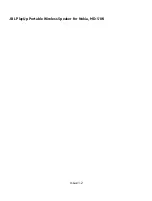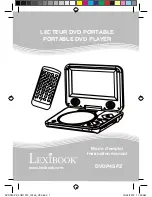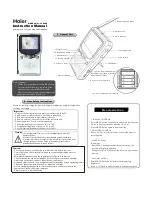
8
OPM-148
REV A
EXHAUST INSTALLATION
WARNING: PERSONAL INJURY
Improper exhaust installation will allow dangerous
gases to seep into enclosed spaces causing a hazard to
your health and/or death.
All exhaust must be piped out of the enclosure. When
selecting a location to exhaust fumes make sure that the
potential for contact with people is controlled. Exhaust can
enter buildings through windows, ventilation systems and
other openings if proper precautions are not followed.
The exhaust must be isolated from the vibration of the
engine. If the exhaust is connected in a rigid system it will
result in damage to the engine. The generator comes
equipped with an engine mounted flex pipe to aid your
installation. Ensure proper alignment with the generator.
The flex can be eliminated if it is pushed to one side to make
a connection.
The most direct path possible should be used to get to the
outside of the enclosure. Each bend restricts the pipe and
increases back pressure. It may be necessary to increase the
exhaust pipe diameter in some applications.
The exhaust pipe is very hot. When passing through the
structure it is critical that a thimble or other appropriate
technique is used to dissipate the heat and prevent the
structure from catching on fire.
It is preferable to exhaust out the side of the enclosures.
Slope the pipe slightly downward away from the engine
to cause any water in the exhaust to run away from the
engine. Do not exhaust near intake. Once outside the
enclosure a rain cap or other technique must be used to
keep water out of the exhaust. In mobile applications make
sure the rain flap faces to the rear of the vehicle so that it is
not blown open during transportation.
The generator ships with a critical grade muffler that should
be installed to decrease noise. It can be mounted either
internally or externally to the enclosure. The muffler cannot
increase back pressure to more than 0.725 psi.
FUEL INSTALLATION
The fuel supply should be as close as possible to the
engine. This will reduce the installation cost of fuel runs.
The information in this manual is offered to assist you in
providing the proper fuel for your engine. However, this
information is only provided to inform you of the engine’s
requirements and assist in making you aware of the
decisions you must make. In no case should the instructions
and information provided be interpreted to conflict with
any local, state or national codes. If in doubt, always consult
your local fire marshal, gas supplier or building inspector.
WARNING: FIRE HAZARD
All fuel runs should be installed by a licensed fuel
supplier.
In no case should the instructions or information provided
be interpreted to conflict with any local, state, or national
codes. If in doubt, always consult your local fire marshal or
fuel supplier.
INSTALLING THE FUEL LINE
WARNING: FIRE DANGER
Connecting rigid fuel line (i.e. steel or copper line)
directly to the inlet fuel filter or fuel pump may cause
the fuel line to crack during operation creating a
serious fire hazard.
The fuel supply should be as close to the engine as
possible. This will reduce the installation cost of fuel runs
and minimize line losses. The diesel fuel supply should be
no more than 3 feet below the fuel inlet on the pump. If
your fuel supply is lower than three feet you may have to
install an additional lift pump to bring the fuel up to the
mechanical fuel pump on the engine.
The information in this manual is offered to assist you in
providing the proper fuel for your engine. However, this
information is only provided to inform you of the engine’s
requirements and assist in making you aware of the
decisions you must make. In no case should the instructions
or information provided be interpreted to conflict with any
local, state, or national codes. If in doubt, always consult
your local fire marshal or fuel supplier.
Engine generator sets are properly adjusted before they
leave the factory. Connecting a fuel supply with adequate
supply volume is critical to reliable operation. Diesel units
with optional base mounted fuel tanks are pre-plumbed to
the mechanical fuel pump on the engine.
Open skid mounted diesel units are often supplied with
capped inlet and return lines. The use of a sustainable
customer supplied flexible fuel line is essential between
the engine and fuel supply to provide a vibration break
between your fuel supply and the engine.
INSTALLING THE BATTERY
CAUTION
In the following battery installation procedure, check
to be sure the DSE 7310 MKII is in the “stop” position.
This should be your last step before initial start-up.
The RP50 is a 12 volt system and requires a single battery.
The batteries should be rated at a minimum of 650 CCA.
Installation of the highest CCA rated battery, within the
correct BCI group, will increase cold weather starting
performance. Gel batteries should not be used with the
battery tender installed in the generator enclosure.
Installation and servicing of batteries must only be
preformed or supervised by personnel knowledgeable of
batteries and the required precautions. Keep unauthorized
personnel away from batteries.
When installing or replacing batteries, use the proper
group/size starting battery. The battery should be a
maintenance-free lead acid design. Deep cycle batteries will
not work for this application.









































